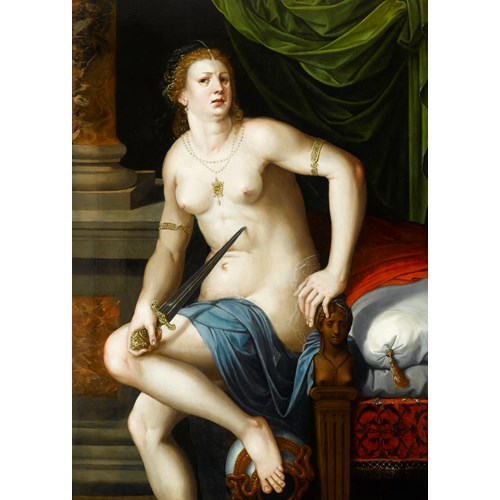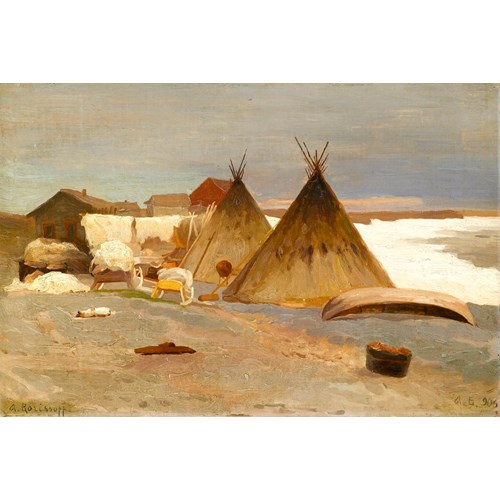Marketplace
Constantinople from the Entrance of the Golden Horn
Thomas Allom
Constantinople from the Entrance of the Golden Horn
Date 1838(?)
Epoque 1750-1850, 19th century
Origine England
Medium Watercolour, Bodycolour
Dimension 30.5 x 42.5 cm (12 x 16³/₄ inches)
The elegant, elongated forms of several caïques glide with great dexterity across the Golden Horn. Guided by the caïque-gees, or boatmen, with their oars made of beech, they are deftly driven forward. In the background lies the glistening city of Constantinople, with the Süleymaniye Mosque rising graciously above it, and the distinctive Beyazit Tower and numerous minarets poking out of the horizon.
Deep into the watercolour, on the left-hand side, one can see a distinctive and longer caïque. Propelled through the waters by eleven or more pairs of oars, it is possibly transporting the Sultan himself, perhaps from Topkapi Palace to a kiosk or another palace further along the Bosphorus. This long vessel is ornately decorated at one end with a magnificent carved and painted curl. At the stern one can see an erected canopy, which would have been made from silk, under which the most important passenger sits. Beside him would be the Reis, a man often chosen for his humour and ability to entertain the Sultan on his journey, who was responsible for guiding the vessel.
Alongside the caïques, large lumbering barges, crammed with people, ferry their passengers to villages along the shore of the Bosphorus. In the foreground, on the left hand side, a bulky and sizeable raft is being strenuously lugged along. Its cargo of timber framing indicates that it is probably destined for the Imperial Naval Arsenal.
Thomas Allom was one of the great artists to travel to the near east in the early 1800s. In 1828 Allom began a fifteen year collaboration with the publishers Fisher Son & Co., and together with William Henry Bartlett (1809-1854), became the two leading illustrators for travel books on Asia Minor.
In 1837 Fisher sent Allom abroad to make sketches of Turkey. He returned to England in April 1838, where he prepared the plates for Fisher’s book Constantinople and the Scenery of the Seven Churches of Asia Minor, 1838, in which the present work was reproduced as the opening plate in Volume 1 before the frontispiece, with the same title.
Robert Walsh provided the descriptive commentary which accompanied Allom’s scenic works in the publication. Walsh had been the chaplain to Lord Strangford’s embassy in Constantinople, and had travelled throughout Turkey from 1821 to 1824. He returned to Constantinople again in 1831, where he remained for a further four years. Thus he had a considerable knowledge of the city.
Although no documents or diaries relating to Allom’s ten month journey exist, one can assume that he spent a lot of time in Constantinople from the number of plates he devoted to the city. None of the preliminary sketches Allom made of Turkey seem to have survived, though we know that he subsequently worked them up into a variety of formats and mediums for many years. One such example is his The Castles of Anadoluhisari and Rumelihisari on the Bosphorus.
The present watercolour is from an existing group that Allom prepared for the engravers, shortly after his return from Turkey. Most tend to be of a similar size, 8 x 11 in, though the present work is much larger, 12 x 16¾ in. The dates of the group of watercolours are usually June or July 1838, and nearly all relate to the plates in the original 1838 edition. This group contains probably the finest Turkish watercolours he produced.
Deep into the watercolour, on the left-hand side, one can see a distinctive and longer caïque. Propelled through the waters by eleven or more pairs of oars, it is possibly transporting the Sultan himself, perhaps from Topkapi Palace to a kiosk or another palace further along the Bosphorus. This long vessel is ornately decorated at one end with a magnificent carved and painted curl. At the stern one can see an erected canopy, which would have been made from silk, under which the most important passenger sits. Beside him would be the Reis, a man often chosen for his humour and ability to entertain the Sultan on his journey, who was responsible for guiding the vessel.
Alongside the caïques, large lumbering barges, crammed with people, ferry their passengers to villages along the shore of the Bosphorus. In the foreground, on the left hand side, a bulky and sizeable raft is being strenuously lugged along. Its cargo of timber framing indicates that it is probably destined for the Imperial Naval Arsenal.
Thomas Allom was one of the great artists to travel to the near east in the early 1800s. In 1828 Allom began a fifteen year collaboration with the publishers Fisher Son & Co., and together with William Henry Bartlett (1809-1854), became the two leading illustrators for travel books on Asia Minor.
In 1837 Fisher sent Allom abroad to make sketches of Turkey. He returned to England in April 1838, where he prepared the plates for Fisher’s book Constantinople and the Scenery of the Seven Churches of Asia Minor, 1838, in which the present work was reproduced as the opening plate in Volume 1 before the frontispiece, with the same title.
Robert Walsh provided the descriptive commentary which accompanied Allom’s scenic works in the publication. Walsh had been the chaplain to Lord Strangford’s embassy in Constantinople, and had travelled throughout Turkey from 1821 to 1824. He returned to Constantinople again in 1831, where he remained for a further four years. Thus he had a considerable knowledge of the city.
Although no documents or diaries relating to Allom’s ten month journey exist, one can assume that he spent a lot of time in Constantinople from the number of plates he devoted to the city. None of the preliminary sketches Allom made of Turkey seem to have survived, though we know that he subsequently worked them up into a variety of formats and mediums for many years. One such example is his The Castles of Anadoluhisari and Rumelihisari on the Bosphorus.
The present watercolour is from an existing group that Allom prepared for the engravers, shortly after his return from Turkey. Most tend to be of a similar size, 8 x 11 in, though the present work is much larger, 12 x 16¾ in. The dates of the group of watercolours are usually June or July 1838, and nearly all relate to the plates in the original 1838 edition. This group contains probably the finest Turkish watercolours he produced.
Date: 1838(?)
Epoque: 1750-1850, 19th century
Origine: England
Medium: Watercolour, Bodycolour
Dimension: 30.5 x 42.5 cm (12 x 16³/₄ inches)
Literature: R. Walsh, Constantinople and the Scenery of the Seven Churches of Asia Minor, Vol. 1, 1838, where reproduced as the first plate.
Plus d'œuvres d'art de la Galerie









